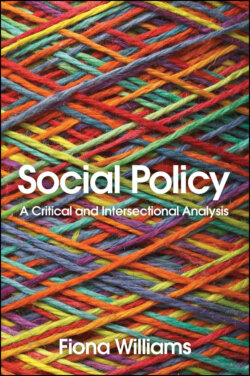Читать книгу Social Policy - Fiona Williams - Страница 22
The crisis of social reproduction and care
ОглавлениеThe crisis of social reproduction has been central to much recent feminist analysis and is variously also called the crisis of care or the care deficit (Floro 2012; Fraser 2013; Williams 2014, 2018) or ‘depletion through social reproduction’ (Rai et al. 2014). There are distinctions between the two concepts ‘social reproduction’ and ‘care’.2 Social reproduction is more general, signifying those social practices of raising and educating children, looking after frail and older people, and feeding and cleaning households. ‘Care’ refers more to relational practices associated with providing and receiving care, to the ethics it embodies, and to care policies and care economies which operate interpersonally, locally, nationally, transnationally and globally. In this book I generally employ the term ‘care’ to cover both sets of meanings.
Care may be paid or unpaid, and as such it captures a range of interconnected social and geo-political inequalities. Women’s inequalities, at work and in the household, relate to the (unpaid) care and domestic responsibilities they carry. Globally, women do most paid care and domestic work, which is generally low-paid and devalued (Razavi and Staab 2012; ILO 2016). The basic and enduring contradiction between capitalism and social reproductive work is that, while part of it – keeping the current and future workforce socialized, healthy and replenished – is essential for economic production, at the same time much of this work is constituted as separate, part of women’s ‘natural’ predisposition, and devalued. Unpaid care is largely invisible in national accounts even though that activity is an indispensable investment for the economy, and where care is paid work it is often low-paid and devalued as ‘unskilled’ (Himmelweit 2018; Bunting 2020). In both these settings, care is further constituted through heteronormative and patriarchal power relations in which classed, racialized, sexualized, generational and disabled inequalities are clearly writ. Of course this is not the only part played by this activity in people’s lives, for it also about love – the profound expressions of mutuality, support and interdependence signified by the ethics of care (see chapters 5, 6 and 7).
However, it is in the imperative for profits extracted from people’s labour that capitalism exerts intense pressure on, and endangers, the capacity of people to care for others and of societies to provide quality care. This is both enduring and intensifying. The present era of global financialized capitalism has heightened this contradiction to the point of crisis (Fraser 2016b). In the West, the normative model has become that of the ‘two-earner’ family.3 While access to paid work has been a long-fought-for right by women, it is now, in the face of wage depreciation, a financially critical necessity for most households, as well as being part of a policy principle of ‘hard-working families’ and labour market activation for self-support. If women’s employment has increased the needs for care support, then it has been further intensified by demographic shifts in developed countries of declining fertility and increased longevity involving longer periods of frail old age. However, within the context of neoliberal welfare, the provision for children, older people and disabled people has been developed by contracting out to the private for-profit sector and providing investment opportunities for multinational companies. However, logics of the market and of care often run in opposite directions (Hudson 2016). A combination of marketization, privatization and social expenditure cuts in many countries after the global financial crisis has given rise to the lowering of conditions of care work, with low wages and zero-hours contracts and poorer accessibility and quality of care. The Covid-19 pandemic was to reveal both the frailty of care markets and the vulnerability of care users and workers (see chapter 4).
The factors contributing to a care crisis in the Global South are both similar and different. The increase in women’s involvement in the labour market and the greater reliance on a woman’s wage has been global (OECD 2015; ILO 2009). While people are also living longer in poorer regions, care crises result from unemployment, wars, ethnic conflict, climate change disaster and chronic illnesses. These place enormous responsibilities on women to maintain sick, young and old family members with little infrastructural support for basic amenities. They also precipitate women into seeking work through migration, often into care and domestic work in developed countries. At the same time, professional households in developed countries, in a context of increased work hours and marketized provision, ease their work–care imbalance by employing migrant or minority ethnic women to do their households’ cleaning and caring. In many countries this is facilitated by state fiscal benefits to those households (Carbonnier and Morel 2015; see chapter 6). In effect, such employment of working-class women of colour, migrant status or lower caste merely obscures those hidden reproductive processes and displaces the effects of the care crisis on to the care workers, families and countries from which they migrate (Williams 2012). While this takes on a new form of worldwide relationship between poorer and richer countries, it also perpetuates a historical racial division of reproductive labour of care work and domestic service provided by women of colour (Glenn 1992). What the existence of this crisis challenges are the priorities of macroeconomic policies of productivism, market competition and consumerism which require the invisibility and subservience of the very processes of human interdependence that enable human flourishing. It is in those struggles – especially by women carers and care workers, trade unions and disability organizations – against the devalued conditions of care and for the state to grant visibility and voice to its users and properly remunerate its workers that these tensions are revealed most clearly (Williams 2010; Esquivel and Kaufmann 2017).
